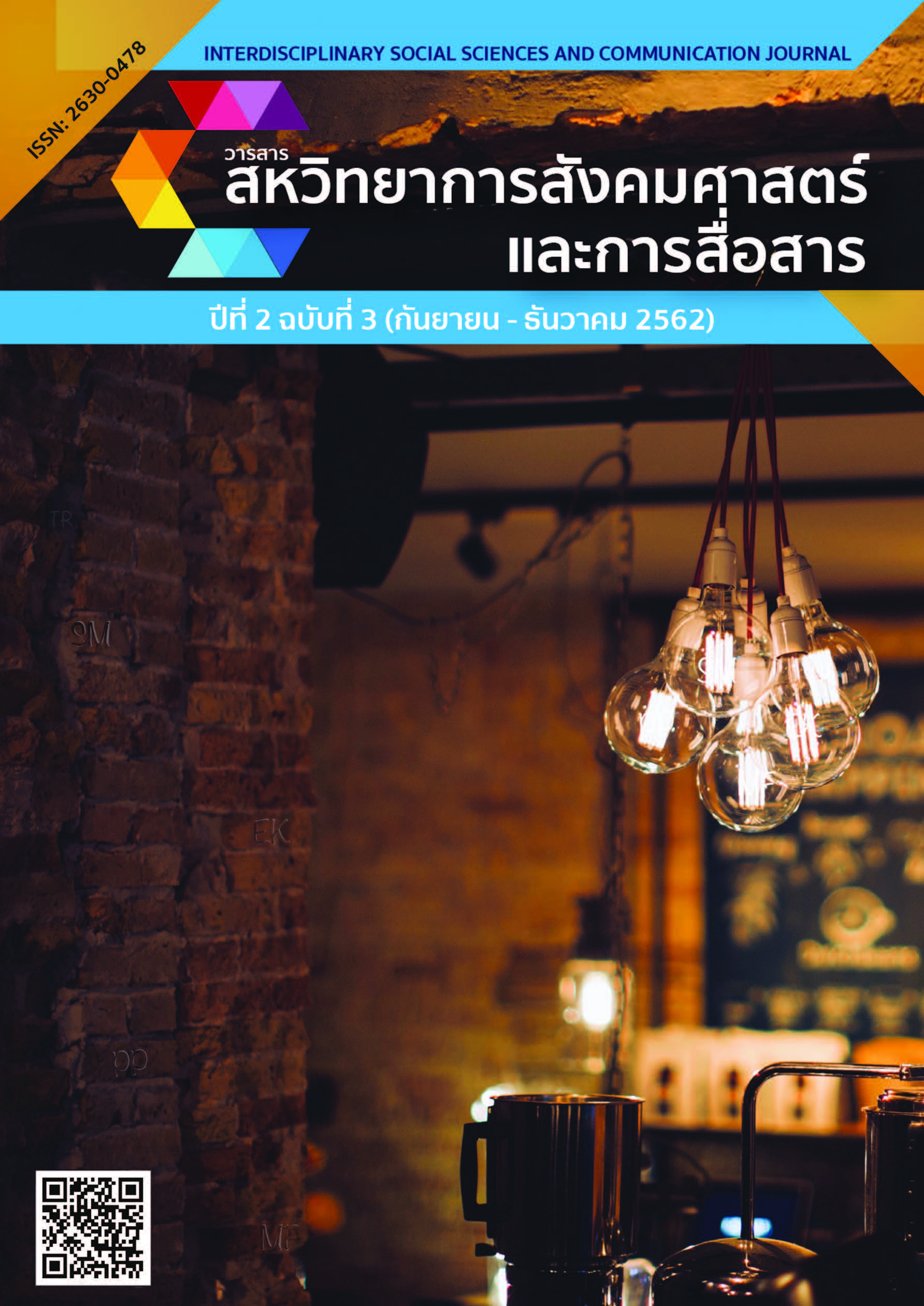การบริโภคสื่อกับการรู้เท่าทันสื่อของคนไทย
Main Article Content
บทคัดย่อ
This research employs a qualitative methodology in order to study 1. media
consumption and media literacy of Thai people and 2. a way of supporting
Thai people’s media literacy. This research uses a semi-constructed interview
form for an in-depth interview of key factors. The key factors include 10 mass
media professionals and academics. The collected data were analyzed by
content analysis. The result shows that: 1. Thai people especially young generation
in the cities have changed their ways of consuming media. A number of their
exposing and using of social media is increasing significantly. Most of them spend
less time on each information exposure but more frequently. Popular activities
done through social media are sending messages, sharing & taking pictures and
chatting via the internet on mobile phones. Most Thai people expose to trivial
information and entertainment programs. 2. A changeable style of media exposure
and the increasing use of social media affect Thai society positively and negatively.
In a positive way, receivers are able to be senders quickly which allow the society
to group and create more negotiation. In a negative way, the society will be a lack
of proof society. This is because people are interested in the speed of sending,
copying and pasting the information rather than spending time to do a research
before sharing and believing the information. 3. Most Thai people have less
media literacy. They have some basic knowledge about the media. However,
they rarely analyze the information and hardly separated facts and opinions.
4. Guidelines for supporting media literacy are as follows. First, government,
private and non- government organizations should cooperate to manage media
literacy both in and outside the educational system. Second, Ministry of Education
should provide teaching and learning on media literacy from kindergarten or
primary level. Third, teaching and learning in media literacy does not require a
fixed format, but should train students to have a skill of critical thinking. Fourth,
the government should supports legal or statutory funding issues through
independent or non-government organizations to promote or campaign on media
literacy by using social media which are the high potential too to access a lot of
people.
Article Details
** ข้อความ ข้อคิดเห็น หรือข้อค้นพบ ในวารสารสหวิทยาการสังคมศาสตร์และการสื่อสารเป็นของผู้เขียน ซึ่งจะต้องรับผิดชอบต่อผลทางกฎหมายใด ๆ ที่อาจเกิดขึ้นจากบทความและงานวิจัยนั้น ๆ โดยมิใช่ความรับผิดชอบของคณะนิเทศศาสตร์ มหาวิทยาลัยราชภัฏรำไพพรรณี **
References
และเยาวชน. ใน สำนักงานกองทุนสนับสนุนการสร้างเสริมสุขภาพ, การพัฒนาองค์ความรู้
การรู้เท่าทันสื่อสุขภาพ สู่หลักสูตรในระบบและนอกระบบการศึกษาของไทย. (น. 55-64).
กรุงเทพฯ: สำนักงานกองทุนสนับสนุนการสร้างเสริมสุขภาพ.
พนิดา สายประดิษฐ์. (2549). ความคิดเห็นของผู้ใช้อินเทอร์เน็ตในประเทศไทยต่อการบริการ
หลอมรวมสื่อ. สาร Nectec ยุคใหม่ Tech Trends: IT, 13(69), 6-10.
สกุลศรี ศรีสารคม. (9 สิงหาคม 2552). การเขียนเพื่อสื่อออนไลน์. สืบค้นจาก http://oknation.
nationtv.tv/blog/ajarnice/2009/08/09/entry-1
สำนักงานคณะกรรมการกิจการกระจายเสียง กิจการโทรทัศน์ และกิจการโทรคมนาคมแห่งชาติ.
(2556). “รู้เท่าทันสื่อ” คืออะไร. สืบค้นจาก http://bcp.nbtc.go.th/th/detail/
2017-01-24-23-12-51
อดุลย์ เพียรรุ่งโรจน์. (2543). การศึกษาแนวคิดเพื่อกำหนดตัวแปรความรู้เท่าทันสื่อ ส?ำหรับการวิจัย
สื่อสารมวลชน. (วิทยานิพนธ์ปริญญามหาบัณฑิต). มหาวิทยาลัยธรรมศาสตร์,
คณะวารสารศาสตร์และสื่อสารมวลชน, สาขาวิชาสื่อสารมวลชน.
เอื้อจิต วิโรจน์ไตรรัตน์. (2540). การวิเคราะห์ระดับมีเดียลิตเตอเรซีของนักศึกษาระดับอุดมศึกษา
ในประเทศไทย. (วิทยานิพนธ์ปริญญามหาบัณฑิต). จุฬาลงกรณ์มหาวิทยาลัย.
Atkin, C. (1973). Instrumental utilities and information seeking. In Clarke, P. (Ed.),
New models for Mass Communication research (pp. 205-242). Beverly Hills,
CA: Sage.
Fidler, R. (1997). Mediamorphosis: Understanding new media. California: Sage.
Klapper, J. T. (1960). The effects of mass communication. New York: Free Press.
McCombs, M. E., & Becker, L. B. (1979). Using mass communication theory. Englewood
Cliffs, NJ: Prentice-Hall.
WP. (2562). ล้วง Insight การใช้งาน “ดิจิทัล” ทั่วโลก 2019 “คนไทย” ใช้เน็ต 9 ชั่วโมงต่อวัน-มือถือ
มี 99 แอปฯ! ! สืบค้นจาก https://www.marketingoops.com/reports/globaland-
thailand-digital-trend-2019/
Suvachittanont, W. (2015). Factors that affect Media Literacy of People in Bangkok.
In Universiti Sains Malaysia, The 4th USM-PSU-NSTRU-MU International
Conference on Arts and Sciences, 14 - 15 December, 2015, University
Conference Hall, Universiti Sains Malaysia, Proceeding of the conference
(p. 48). Penang: Malaysia.

